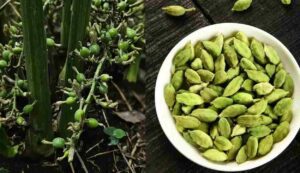Cultivation of Cardamom: Earn lakhs every month by cultivating cardamom, know the method of cultivation
Cultivation of Cardamom: In India, spices have a distinct significance. Every Indian kitchen has a unique spice scent. The “Queen of Spices” is the term given to cardamom. Food, beverages, sweets, and Ayurvedic medications all heavily include its flavor and scent. This explains why the Indian market consistently sees a need for it. In this case, cardamom may be a one-time investment that yields consistent profits for many years, provided farmers grow it properly.

We learned some crucial facts regarding cardamom production in today’s essay, which will be very beneficial to farmers.
Why should Cardamom be Grown?
- Good pricing in the market: Depending on quality, cardamom costs between Rs 1,000 and Rs 2,500 per kilogram.
- Long-term profits: Cardamom trees produce for ten to fifteen years after they are planted.
- Demand throughout the year: Both the local and foreign markets continue to have a need for it.
How is Cardamom Grown?
Soil and Climate
- Temperatures between 10°C and 35°C and 1500–4000 mm of precipitation are required in tropical regions.
- The best soil types are said to be red loam, laterite, or black soil with a pH of 5 to 7.5.
- Because cardamom prefers shade, 50–60% shade is necessary.
Preparation of the Land
- Make the field flat by plowing it thoroughly.
- Make sure drainage is set up correctly.
- Applying organic manure will increase the fertility of the soil.
Planting
- The monsoon season (July) is the ideal time to plant.
- For big plants, maintain a gap of 2.5 x 2 meters; for tiny plants, maintain a spacing of 2 x 1.5 meters.
- Growing plants from seeds takes longer than growing them from rhizomes or cuttings.
Watering
- During the summer, water every fifteen days.
- During the monsoon, water is only used as needed.
- Drip irrigation offers enough moisture and conserves water.
Fertilizers and Manure
- Add 10–15 tons of organic manure per acre, such as cow dung manure.
- Use fertilizers such as phosphate, potassium, and nitrogen after testing the soil.
Gathering and Preparing
- In two to three years, the plants begin to produce fruit.
- Break the pods when they are ripe and use a dryer or the sun to dry them.
- Sort them after they’ve dried and get them ready for sale.
What is the potential profit?
- 400–800 kg of dry cardamom are produced per acre.
- The revenue ranges from Rs 6 lakh to Rs 12 lakh if the price is set at Rs 1,500 per kilogram.
- The net profit after expenses are subtracted might range from Rs 3 lakh to Rs 5 lakh.
What government assistance is available?
The Spices Board offers farmers financial and technical support so they may grow cardamom and make a healthy profit. In addition, the National Horticulture Mission (NHM) provides farmers with subsidies for plantations, irrigation, and storage. Farmers may get additional information about this facility by getting in touch with the Spices Board office or their district’s Horticulture Department.

